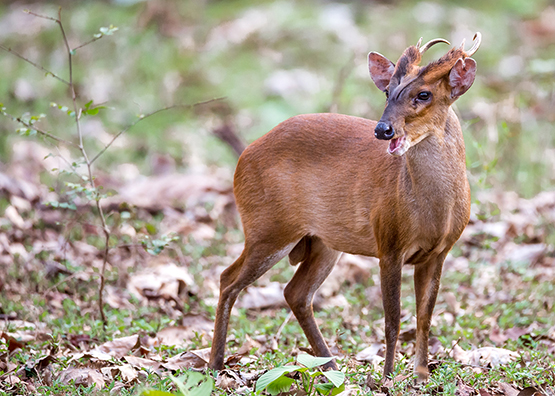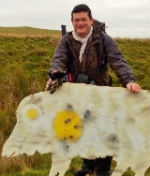Dr Simon Lee reflects on the bigger picture of UK wildlife and considers the role of man in environmental management and mismanagement.

Our little patch of shooting permission is a delight, fields, woods, and a river running through it. A river scrupulously managed by a trout syndicate who stock the area with hatchling that then grow to be caught and possibly eaten, the riverine equivalent of pheasants, so I am told!
Reintroduction
From watching the news, I see that some beavers have been reintroduced to the UK, nowhere near our area, I hasten to add. Whereas I applaud and encourage biodiversity, I cannot help feeling suspicious about this. The trend for ‘re-wilding' schemes in the UK fails to address the root cause of the species dying out in the first place, in beaver terms, we hunted them for fur, they were subject to a loss of habitat and predation, and really that is all it takes to wipe out a population of anything, and extinct is sadly forever!
But back come the beavers, into an environment where, in their absence, things have moved on, waterways repurposed, flood tables redefined, and predator levels skewed. Let us see how they fare...
Other schemes to reintroduce lynx and wolf back to the UK have been mooted, to furious debate from some quarters, wolves are a particularly emotive subject. Foxes have a certain cachet of affection but a few steps back on the Linnean classification system we lose all sympathy for the vulpine! Why?
As a reintroduced wolf with survival as a priority, I would hunt the easiest species available, the fields of domesticated stock would be my starting point before taking my chances in the more competitive wild prey environment. The debate thunders on but if I were a livestock farmer, I would certainly have a firm opinion....
Back in our deer sphere, a few definitions may help,
- Native and non-native
- Escaped
- Invasive
Native and non-native
It is a fact that the only two native species of UK deer are the red and the roe. But were a member of the public asked to describe a deer, a lot may describe fallow, who have been with us since the trend for estate deer parks to delight the landed gentry started hundreds of years ago.
Has enough time passed for the fallow to be considered ‘one of ours'? Originally from Turkey and other parts of the northern Levant, I tend to view fallow as an adopted species, and a welcome one at that, despite my personal love/hate relationship from difficulties in controlling wild fallow populations with their unpredictable habits...
Escaped
In mid-October 1987 in the UK, we suffered what has gone down in local legend and Wikipedia as ‘the Great Storm', winds of up to 135 mph that blew for two days caused chaos right across the country, leaving a trail of damage in its wake.
Trees, fences, roofs, and structure generally were impacted, none less so than certain farms with wild boar stock, who promptly escaped and vanished into the surrounding countryside. These escapees may have bred with the rare feral boar in the Forest of Dean to produce a new hybrid species. Other populations in the Moffat area of Scotland were also affected to a degree genetically.
Having some limited experience with continental boar, my first sighting of this wild UK boar hybrid was a bit of a shock, my initial reaction was, ‘it’s the wrong colour!’ but a boar it surely was, physiologically speaking, in all its ginger glory. A choice of a larger calibre, .308 was preferred, and with a torchbearer with a steady hand, that was that! The proof was in the pudding, in this case homemade black pudding, as I hate to waste anything.

In similar circumstances, in this case a Luftwaffe air raid, the estate of the Duke of Bedford, (himself an avid collector and breeder of exotic species), was left ungated and some of his imported muntjac escaped to freedom, causing the spread of muntjac through the UK that we are seeing to this day.
Occupying a niche in the understorey from being a forest-based species, these tough little deer have slotted firmly into their new environment, much debate is heard of negative interactions between muntjac and roe, I have personally seen a diminutive muntjac buck drive away two far larger roe, and from anecdotal evidence, this territorial behaviour isn’t uncommon between the two.
Blame for stripped bark on saplings also has fallen on native roe, but I’ve also seen munties stand up on their back legs to browse, negating the accepted wisdom about attributing heights of nibbled ivy to deer species. Are munties getting the roe in trouble? If they are, then it’s working, as a species, muntjac are doing well, unlike the Chinese Water deer, who struggle with a different breeding cycle and their own environmental requirements and are therefore restricted to swampier parts of England.
As for the last of the UK deer, the sika, originally from the Far East, they are causing considerable damage running into thousands of pounds to tree plantations, these nocturnal whistlers have also crossbred with the red deer to form another new hybrid, who I’m told by those responsible for their management, are targeted with maximum prejudice to maintain the genetic integrity of both species.
As a side note, these distinctive deer all hail from a pair that Edward VII gave to the Baron of Beaulieu in the 1900s, another open gate, and another lapse of attention, and now we have got six species of deer in the UK...
Invasive
The definition of an invasive species states that the subject has ‘a negative impact on its environment ‘, but are these escaped species truly in that category? Moving over to flora from fauna momentarily, no one can dispute the havoc wrought by the likes of Japanese knotweed, Russian kudzu vine, and even rhododendrons, even ugly Leylandii firs are subject to neighbourly scrutiny...
But are muntjac really causing negative impact? One permission we enjoy was gained specifically to deal with the perceived problem of muntjac eating young blooms in an ornamental garden. Our trail cameras revealed the prime suspects as rabbits but featured an alarming tendency for muntjac to dig up and consume dormant tulip bulbs, so that was that, caught red handed!
Can competition for territory be considered negative impact? I have seen enough roe knocking each other about for territory and status to think that a few muntjac are not going to change the picture too much. My final analysis is that muntjac are just another part of our local environmental picture and I am glad to have them aboard for sheer joy of biodiversity
Back to local fauna and our patch, cooperation between the trout syndicate and the stalkers resulted in a collaboration that identified three unarguably invasive species and produced our own little local MacNabb, grey squirrel carcasses were used to bait pots for red signal crayfish which then attracted and caught greedy black mink, none of whom it is legal to return to the water...
In my humble view, these three ‘crosspond’ invasive species all need to be stoutly and regularly culled to protect both the existing species, the riverbank itself, and it is introduced stock.
The trout syndicate man seemed pleased with our efforts, and we ate the crayfish ourselves....
 To read more from Simon follow this link to an article in which he provides a superb insight into making Venison Jerky: how-to-make-venison-jerky
To read more from Simon follow this link to an article in which he provides a superb insight into making Venison Jerky: how-to-make-venison-jerky



















